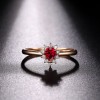| Style: | Inspired | Setting Type: | Claw |
|---|---|---|---|
| Au750 | Occasion: | Wedding,anniversary,engagement,gift | |
| OEM: | Accepted | Gemstone Color: | Red |
Ruby Ring Gemstone 18K Solid Rose Gold Round Natural Ruby Anniversary Wedding Band Ring
Centre Stone:
Natural Ruby
3x5mm in Diameter
Weights 0.26ct-0.56ct
Pear Cut
Side Stone:
10 natural white diamond accents
Round cut
G-H color
SI clarity
18K Rose Gold Band
High Polish Finish
Weights 1.16g-1.590 Grams
Gemstone Ring
Customized Size
Picture Details:



Ruby- The king Of Gemstone
This bright red gemstone is one of the best known gemstones in the world. The word ruby is derived from the Latin word ‘ruber’ meaning red. Natural rubies are quite rare and expensive.
Larger transparent rubies are exceptionally rare, far more rare than diamonds. Some rubies have a slight blue hue to them, this is referred to as ‘pigeon blood-red’ these precious gemstones fetch the highest price.
Ruby Through The Ages
Rubies have always played an
Once this precious deep red stone made its way to Europe over the Silk Route, royalty was quick to include them in crowns and precious jewelry of their own. Though in that time no distinction was made between rubies, red garnets or spinels. The ‘Black Ruby’ and ‘Timur Ruby’, part of the British crown jewels, are in fact spinels.
In 1837 the first synthetic rubies were made, a process that was perfected since that time. They have many uses especially in equipment that requires exceptionally durable parts and in red ruby lasers.
Rubies are becoming increasingly popular. For example a ruby engagement ring is considered to be above a diamond engagement ring because of it’s rarity and vibrant, rich colors.
Interesting Ruby Properties
Ruby stones are extremely hard. Only diamonds and moissanite are harder natural gemstones. The red color of the ruby gemstone is caused by chromium that has replaced a part of the aluminium-oxide that makes up the stone. When chromium absorbs yellow-green light (which is a part of sunlight) it emits it again as red luminescence. Giving the ruby an even deeper red colour.
The only way to find out whether you are dealing with a synthetic ruby or a natural ruby is by looking at their imperfections. Every natural stone has small imperfections of colour and inclusions of rutile needles (called silk). These inclusions do not diminish the value of a ruby as long as the red color of the gemstone remains. Synthetic stones do not have these imperfections and perfect rubies are usually suspected of being fake rubies.





